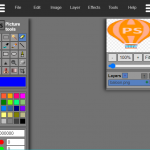Online Photoshop creates, opens, and imports images
Create an image
1. Select File > New.
2. Type a name for the image in the New dialog box.
3. Optionally, select a document size from the Document Type menu.
Note:
To create a document with a pixel size set for a specific device, click the Device Central button.
4. Set the width and height by selecting a preset from the Size menu or by entering values in the Width and Height text boxes.
Note:
In order to make the width, height, resolution, color mode, and bit depth of the new image exactly match any open image, select a file name from the bottom of the document type menu.
5. Set the resolution, color mode, and bit depth.
If you copy a selection to the clipboard, the image size and resolution are automatically based on that image data.
6. Select the Background Content option:
white
Fill the background layer with white (the default background color).
Background color
Fills the background layer with the current background color.
transparent
Makes the first layer transparent with no color value. The final document content will contain a single, transparent layer.
Miscellaneous Opens the Color Picker dialog box to select a background color. For more information, see Adobe Color Picker overview.
7. Optionally, if necessary, click the Advanced button to display more options.
8. Optionally, under Advanced, choose a color profile, or choose Don’t color manage this document. For Pixel Aspect Ratio, choose Square Pixels unless you’re using an image for video. For video images, select a different option to use non-square pixels.
9. When you’re done setting up, you can click Save Presets to save them as presets, or click OK to open a new file.
Duplicate the image
You can copy the entire image, including all layers, layer masks, and channels, to available memory instead of storing it on disk.
1. Open the image you want to copy.
2. Select Image > Copy.
3. Enter a name for the copied image.
4. If you want to duplicate the image and merge the layers, select Copy merged layers only. To keep the layer, make sure this option is deselected.
5. Click OK.
Open the file
You can use the Open command and the Recently Opened Files command to open a file. You can also open files from other Adobe applications, such as Illustrator, Fresco, Lightroom, or Bridge, in Photoshop.
Some files, such as camera raw files and PDF files, must be opened with settings and options specified in a dialog box to be fully open in Photoshop.
In addition to static images, Photoshop users can also open and edit 3D files, videos, and image sequence files. For more information, see Import video files and image sequences.
Note:
Photoshop uses plug-in modules to open and import a variety of file formats. If a file format does not appear in the Open dialog box or in the File > Import submenu, you may need to install a plug-in module for that format.
Sometimes, Photoshop may not be able to determine the correct format of a file. This happens, for example, when transferring files between two operating systems. Sometimes, transferring between Mac OS and Windows results in the wrong marking of the file format. In this case, the correct format must be specified for the open file.
Note:
When you import an Illustrator picture into Photoshop, you can (as much as possible) preserve its layers, masks, transparency, compound shapes, slices, image maps, and editable types. In Illustrator, export the picture in Photoshop (PSD) file format. If your Illustrator image contains elements that are not supported by Photoshop, the appearance of the picture is preserved, but the layers are merged and rasterized to the picture.
Use the open command to open the file
1. Choose File > Open.
2. Select the name of the file you want to open. If the file does not appear, you can select the option to display all files from the File Type (Windows) or Enable (Mac OS) pop-up menu.
3. Click Open. In some cases, a dialog box appears that you can use to set specific options for formatting.
Note:
If a color profile warning message appears, specify whether to use the embedded profile as the workspace, convert the document color to the workspace, or undo the embedded profile.
Open a recently used file
1. Choose File > Recent Files, and select a file from the submenu.
Note:
To specify the number of files listed in the Recent Files menu, change the Recent Files List Contains option in the File Handling preferences. Choose Edit > Preferences> File Handling (Windows) or Photoshop> Preferences > File Handling (Mac OS).
Specifies the file format used to open the file
Photoshop might not be able to open a file if you store it with an extension that doesn’t match the file’s actual format (for example, a PSD file with the extension .gif), or if the file doesn’t have an extension. Choosing the right format will enable Photoshop to recognize and open the file.
1. Do one of the following:
o (Windows) Choose File > Open As to select the file you want to open. Then choose the format you want from the Open As pop-up menu and click Open.
o (Mac OS) Choose File > Open, choose All Documents from the View pop-up menu. Then select the file you want to open, choose the desired file format from the Format pop-up menu, and click Open.
Note:
If the file isn’t opened, the format you chose might not match the actual format of the file, or the file might be corrupted.
Open the PDF file
The Adobe Portable Document Format (PDF) is a universal file format that can represent vector and bitmap data. It has electronic document search and navigation capabilities. PDF is the primary format for Adobe Illustrator and Adobe Acrobat.
Some PDF files contain only one image, while others contain multiple pages and images. When you open a PDF file in Photoshop, you can choose which page or image to open and specify rasterization options.
You can also use the Place command, the Paste command, and drag-and-drop functionality to import PDF data. The page or image is placed as a separate layer as a Smart Object.
Note:
The following procedure applies only to opening a normal PDF file in Photoshop. When you open a Photoshop PDF file, you do not need to specify options in the Import PDF dialog box.
1. Do one of the following:
o (Photoshop) Choose File > Open.
o (Bridge) Select the PDF file and select File > Open With >Adobe Photoshop. Skip to step 3.
2. In the Open dialog box, select a name for the file, and then click Open.
3. In the Import PDF dialog box, under Select, depending on the elements of the PDF document you want to import, select Pages or Images.
4. Click the thumbnail to select the page or image you want to open. Shift-click to select multiple pages or images. The number of selected items is displayed below the preview window. If you’re importing images, skip to step 8.
Note:
You can use the Thumbnail Size menu to adjust the thumbnail view in the preview window. The Fit to Page option is used to display a thumbnail image throughout the preview window. If there are multiple items, a scroll bar will appear.
5. To give a name to the new document, type a name in the Name text box. If you want to import multiple pages or images, multiple documents will be opened, each with a base name followed by a number.
6. Choose an item from the Crop To menu under Page Options to specify which parts of the PDF document to include:
Outline frame
Crop to the smallest rectangular area that contains all the text and graphics on the page. This option is used to remove excess white space and any document elements other than the crop box.
Note:
Borders do not crop blank space that is part of the background created by the source application.
Media box
Crop to the original size of the page.
Crop box
Crop to the clipping area (crop margins) of the PDF file.
Bleed box
Crop to a specified area in a PDF file to meet inherent limitations in the production process, such as cutting, folding, and cropping.
Crop box
Crop to the area specified to get the expected final page size.
Piece frame
Crop to a specified area in a PDF file for embedding PDF data in other applications.
7. Under Image size, enter a value for width and height (if necessary).
o When you scale a page in a rectangle defined by width and height values, select Constraint Scale if you want to preserve the aspect ratio of the page.
o To scale the page precisely by the width and height values, deselect Constraint Scale. Distortion may occur when the page is zoomed.
When you select multiple pages, the Width and Height text boxes display the maximum width and height values for the selected page, respectively. If Constraint Scale is selected and you don’t change the width and height values, all pages will be rendered at their original size. If you change these values, when you rasterize the pages, all the pages are scaled proportionally.
8. Under Image Size, specify the following options:
resolution
Set the resolution of the new document. See also About pixel size and print resolution.
mode
Sets the color mode for the new document. See also Color modes.
Bit depth
Sets the bit depth of the new document. See also Bit Depth.
The combination of width values, height values, and resolution will determine the final pixel size of the resulting document.
9. To suppress color profile warnings, select Disable Warnings.
10.Click OK.
Open the EPS file
Compressed PostScript (EPS) can represent both vector and bitmap data, and is supported by almost all graphics, illustration, and typesetting programs. The Adobe application that primarily generates PostScript images is Adobe Illustrator. When you open an EPS file that contains a vector image, it is rasterized, and the mathematically defined lines and curves in the vector image are converted to pixels or bits of the bitmap image.
You can also use the Place command, the Paste command, and drag-and-drop functionality to import PostScript images into Photoshop.
1. Choose File > Open.
2. Select the file you want to open and click Open.
3. Specify the desired size, resolution, and mode. To maintain the same aspect ratio, select Constraint Proportion.
4. To minimize jagged lines on the edges of the picture, select Anti-aliasing.
Please indicate:Free Editor Online Photoshop » Online Photoshop creates, opens, and imports images






 Gender Double Label Revealed 9 Illustrations Reveal the Invisible Rules Around Us!
Gender Double Label Revealed 9 Illustrations Reveal the Invisible Rules Around Us!





Login to comment! If you already have an account, please first log in,No please registered or